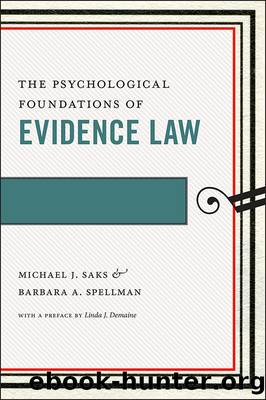The Psychological Foundations of Evidence Law by Michael J. Saks & Barbara A. Spellman

Author:Michael J. Saks & Barbara A. Spellman [Saks, Michael J. & Spellman, Barbara A.]
Language: eng
Format: epub
Tags: LAW000000 Law / General
Publisher: New York University Press
Legal Policy Implications
The findings we have reviewed concerning the weakness of person variables, standing alone, as predictors of particular conduct, and the advantages gained by adding consideration of situational variables suggest some lessons for the law of character evidence.
In most cases it is not likely that personality, or character, by itself, causes or predicts behavior with enough consistency to allow factfinders to accurately account for conduct from evidence of characterâeven assuming factfinders were provided with accurate evidence of a personâs character. Errors of overprediction will be common. Consequently, the prohibition on propensity appears to be a sensible legal policy. Given how misleading propensity evidence can be, and the excessive confidence that people have in such information, the prohibition probably makes even more sense than the common law judges who invented and preserved the rule over the past three centuries fully appreciated.
On the other hand, we have noted that past behavior is a better predictor of future behavior than personality variables are. This phenomenon would be especially true if the circumstances under which the behavior occurred were known and they paralleled those of the current case being tried. Why, then, not allow such evidence even if character evidence remains forbidden? Interestingly, the rules governing the manner of presentation of character evidence bar exactly such specific-instances-of-conduct testimony. That, obviously, could be changed if specific instances of behavior came to be recognized as more probative and the barrier to admission removed. One explanation for non-admission might be the finding that people make spontaneous trait inferences from descriptions of behavior to personality. Thus, the step from behavior to character is a very short oneâand from there we are back to the problem of overconfident and inflated postdictions about the disputed behavior at issue in the case.
Thoughtful commentators have pointed out that low base rates of a behavior (e.g., only a tiny percentage of the population commits homicide)âwhich go hand in hand with poor accuracy and high overprediction errorsâmight still be quite relevant and might nevertheless help factfinders reach correct verdicts.49
For example, if the question is whether a murdered woman was killed by her husband/boyfriend, is it useful to know that the man physically abused the woman during their years together? Suppose we know that of every 100,000 battered women, 45 end up being murdered (by anyone) and 99,955 are never murdered. This information would not help you predict that a battered woman will end up being a murdered woman, since it so rarely happens. But the question before a jury is different: given that a woman has been murdered, is it helpful to know that she had been a battered woman and that her partner was the batterer? Suppose the data show that of the 45 out of 100,000 battered women who are murdered, 40 are murdered by their partners and 5 by someone else. Now we know that battered women who are murdered are eight times more likely to have been murdered by their partners than by someone else. This clearly is relevant information by the lawâs definition.
Download
This site does not store any files on its server. We only index and link to content provided by other sites. Please contact the content providers to delete copyright contents if any and email us, we'll remove relevant links or contents immediately.
The Borden Murders by Sarah Miller(3597)
The Secret Barrister by The Secret Barrister(3016)
Coroner's Journal by Louis Cataldie(2109)
Police Exams Prep 2018-2019 by Kaplan Test Prep(2041)
The Splendid and the Vile by Erik Larson(1794)
Terrorist Cop by Mordecai Dzikansky & ROBERT SLATER(1724)
A Colony in a Nation by Chris Hayes(1513)
My Dark Places by James Ellroy(1511)
Black Klansman by Ron Stallworth(1449)
A Life of Crime by Harry Ognall(1384)
Objection! by Nancy Grace(1338)
Whoever Fights Monsters by Robert K. Ressler(1326)
The New Jim Crow by Michelle Alexander(1320)
American Prison by Shane Bauer(1292)
Obsession (The Volkov Mafia Series Book 1) by S.E Foster(1283)
Anatomy of Injustice by Raymond Bonner(1273)
The Art of Flight by unknow(1268)
A Higher Loyalty by Comey James(1245)
A is for Arsenic: The Poisons of Agatha Christie (Bloomsbury Sigma) by Kathryn Harkup(1217)
